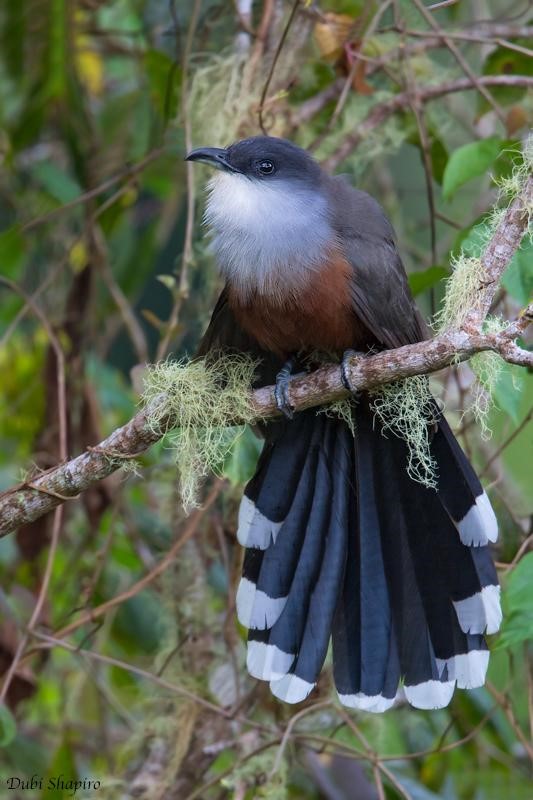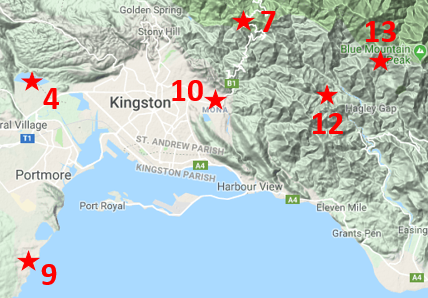The Avitourist’s Guide to Jamaica

The endemic Chestnut-bellied Cuckoo. © Dubi Shapiro
For birdwatchers, Jamaica is a target-rich environment. Its total of 30 endemic species ranks 16th among countries worldwide, far disproportionate to its size. Compared to the other large Caribbean islands, Jamaica offers the best odds of a clean sweep, as none of its endemics is especially difficult to find. It is even possible (though not likely) to find all of these birds at a single site, Ecclesdown Road. For more information on its birds, see Birds of Jamaica.
Jamaica makes an interesting destination for many other pursuits as well. It is rich in natural beauty, decorated with picturesque beaches and waterfalls, and lush, exuberant vegetation. In the human domain, Jamaica is the epicenter of Anglo-Caribbean culture, the origin of reggae music and Rastafarian religion—together personified in Bob Marley, whose music remains prominent on the national soundtrack.
Jamaica has one the best-developed tourist infrastructures in the Caribbean, with both positive and negative consequences. On the negative side, Jamaica’s long-term economic reliance on tourism creates a dehumanizing social dynamic that reduces far too many of its citizens to begging, hustling, and petty crime, and casts tourists as shakable money-trees. More positively, Jamaica is well-equipped to accommodate visitors, and offers an abundance of options for customizing a vacation outside of its narrow tourist corridors.

The endemic Jamaican Mango. © Clive Daelman
Due to the relative ease of finding its unique species, Jamaica offers the advantage of flexibility to the traveling birdwatcher. A well planned, concerted effort can yield all the endemics in short order. That makes Jamaica amenable to a wide range of approaches, including vacations that combine birdwatching with other pursuits.
The map below shows many of Jamaica’s favored birdwatching locations, with links to detailed accounts of certain locales. Read beyond that for general orientation on possible game-plans for visiting Jamaica.
For more detailed logistical guidance and a directory of ecotour operators, see Travel to Jamaica.
Jamaica – Orientation Map


1 – Barbecue Bottom / Burnt Hill Road
2 – Black River Lower Morass
4 – Caymanas Ponds
5 – Ecclesdown Road
6 – Font Hill Nature Reserve
7 – Hardwar Gap
8 – Hector’s River
9 – Hellshire Hills
10 – Hope Gardens
11 – Marshall’s Pen
12 – Mavis Bank
13 – Portland Gap
14 – Portland Ridge
The East End
To find all of Jamaica’s endemics as efficiently as possible, fly into Kingston and focus on two sites near the eastern end of the island:
Ecclesdown Road (Site #5) for Black-billed Streamertail, Black-billed Parrot, Yellow-billed Parrot, Jamaican Crow, and almost every other endemic.
Hardwar Gap (Site #7) for Large Jamaican Elaenia and any endemics missed at Ecclesdown Road—in particular, Crested Quail-Dove, Jamaican Owl, Small Jamaican Elaenia, “Jamaican Solitaire,” and Jamaican Blackbird are often easier to find at Hardwar Gap.
Both can be visited as day trips from Kingston or Port Antonio. However, Hardwar Gap is much more convenient to visit from Kingston, and Ecclesdown Road is much more convenient from Port Antonio, so it is advisable to find accommodations in each location for a couple of nights.
Kingston: Staying in or near Kingston also allows for a quick visit to the Hellshire Hills (Site #9) or a longer trip to Portland Ridge (Site #14) to look for Bahama Mockingbird, as well as a handful of productive wetland sites. Those with time to spare in Kingston will likely want to visit Hope Gardens (Site #10), which usually has Yellow-billed and sometimes Black-billed Parrots.
Port Antonio: Staying in Port Antonio—preferably in the adjacent resort community San San (Site #18)—allows more time to look for “Atlantic White-tailed Tropicbird” at Hector’s River (Site #8), and to enjoy local touristic sites such as the Blue Lagoon and several attractive beaches.
As a nearby alternative to Kingston, some visitors use Mavis Bank (Site #12) as a local base. Doing so facilitates a visit to Portland Gap (Site #13) and Blue Mountain Peak (a strenuous hike to the highest point on Jamaica), where all the birds of Hardwar Gap can be found in a more remote setting.
Another viable plan is to stay in Robin’s Bay (Site #15)—ideally at Green Castle Estate, where you can find most of the widespread endemics, including Jamaican Owl, and sometimes West Indian Whistling-Duck and Yellow-breasted Crake—and make day trips to Hardwar Gap and Ecclesdown Road. In this case, the day trips to both sites would involve significant drives.
Cockpit Country
To find most of the same species in the west-central part of the island, an alternative approach would be to focus on Cockpit Country, which supports populations of all but three of the endemics (Black-billed Streamertail, Large Jamaican Elaenia, and “Jamaican Solitaire”). The main sites to consider there are:
Stewart Town (Site #19), readily accessible by road and easy walking—possibly the best site on the island for easy observation of most of the endemics.
Windsor (Site #21), where you can stay overnight at a biological research station in Cockpit Country.
Barbecue Bottom / Burnt Hill Road (Site #1), a decommissioned road that cuts a transect through the Cockpit Country wilderness.
Excursions into Cockpit Country are possible as day trips from the major tourist hubs of Montego Bay, Falmouth, and Ocho Rios, or by staying in a rural community off the tourist circuit.
The Southwest
Southwestern Jamaica is not the best part of the island for endemics, but many visitors enjoy its comparative isolation, dry climate, and spectacular sights such as Lover’s Leap and Floyd’s Pelican Bar. For birdwatchers, there are three big draws:
Marshall’s Pen (Site #11), the privately owned ranch, plantation, nature reserve, museum, and home to the prominent Jamaican ornithologists Robert Sutton (who was killed during a robbery) and his wife Ann Haynes-Sutton. Most of the endemics can be found on the property, often including cooperative Jamaican Owls, but visits must be arranged well in advance.
Black River Upper Morass (Site #3), where many species of waterbirds, including Yellow-breasted Crake and Spotted Rail, can be found. Not to be confused with Black River Lower Morass (Site #2), which also supports these species but lacks convenient access to its best habitat.
Portland Ridge (Site #14), an intact patch of dry thorn forest with Bahama Mockingbird, Plain Pigeon (seasonally), and an adjacent mangrove swamp.
Many visitors who avoid commercialized resort areas but enjoy seaside vacations are drawn to Treasure Beach (Site #20), which gives access to a little-explored section of Jamaica with several large saline lagoons that support large numbers of migratory waterfowl and shorebirds.
Beach Vacations
Jamaica is an excellent destination for vacations that combine seaside relaxation with birdwatching. The resorts and beach towns spread along the northern coast from Montego Bay to Ocho Rios are all within 90 minutes’ drive of Stewart Town, which is among the best sites for finding all but a few of the island’s endemics.
Also accessible from Montego Bay is the venerable Rockland Bird Sanctuary, a bird-feeding station since 1962, where hummingbirds are known to perch on visitors’ fingers and about half the endemics can be found on a good day.
Farther from the beaten path, at the eastern end of Jamaica, San San is a scenic beach town that has preserved much of its natural habitat and is a birdwatching destination in its own right. San San is a short drive from Ecclesdown Road and within day-trip striking distance of Hardwar Gap, and thereby provides a reasonable opportunity to find all the endemics.
Cruise Port-Calls
Falmouth has become Jamaica’s principal cruise ship port. This is a fortunate development for cruising birdwatchers, as Falmouth is just 45 minutes’ drive from Stewart Town. If a driver can be arranged promptly or in advance, an 8-hour call in Falmouth could yield four hours at Stewart Town, enough time to find most of Jamaica’s endemic birds.
Some of the tour operators at the Montego Bay cruise ship port offer regular tours to Rocklands Bird Sanctuary. This is likely the easiest way to see a few of the endemics, and definitely the best way to see hummingbirds and Caribbean Dove at close range, but it does not offer the diversity of Stewart Town.